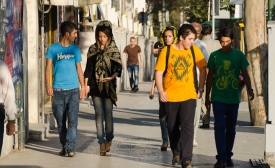international broadcasting
U.S. Marines raised the Stars and Stripes over the newly reopened American Embassy in Cuba on Friday as Secretary of State John Kerry made an unprecedented nationally broadcast call for democratic change on the island ruled by a single party for more than five decades.
"In Iran today, freedom of the press remains a dream," Cohler-Esses writes. "But freedom of tongue has been set loose. I was repeatedly struck by the willingness of Iranians to offer sharp, even withering criticisms of their government on the record, readiness sometimes even to be filmed doing so."

Reprinted from the CPD Blog by Philip Seib (Apr 7, 2015)
Iran's Tasnim news agency has reported an announcement by the Ministry of Culture and Islamic Guidance about lifting the ban on BBC operations inside of Iran. The Ministry is responsible for Iran's domestic and foreign press regulations.
One state media take veered dangerously close to racism: on July 24, the day Obama arrived in Kenya’s capital city Nairobi, the English language website of state-run outlet Global Times ran a cartoon titled “Homecoming,” portraying the president wearing what appeared to be tribal attire and carrying a spear near a herd of zebra on an open plain.
Interviews with defectors reveal that many listen to news from shortwave radios, despite fear of severe punishment, and there is a new $50 portable media device providing a window to the outside world – despite the government’s best efforts to isolate its population.
The debate over what to call the Islamist extremist group that controls parts of Iraq and Syria has been raging for well over a year now. [...] Cameron's logic is simple: Calling the group "Islamic State" defers upon it a religious legitimacy and sense of statehood that should be denied.
The Foreign Ministry took a stab at the international media's coverage of Gaza in a satirical, animated video posted on the Internet on Sunday. Ahead of a UN Human Rights Council report due to be published this week on last summer's war between Israel and Hamas in Gaza, the ministry issued the clip intended to urge the world to become more aware of the realities of oppression and terrorism in the coastal Palestinian territory.







